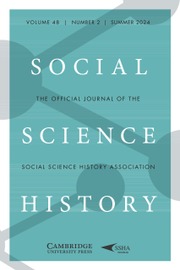Article contents
Extract
This special issue on the working classes and urban public space presents readerswith an opportunity to view new scholarship at the intersection of urban andworking-class history and to explore the spatial dimensions of class, race, andgender analysis. The authors of the essays present us with important casestudies of how the working classes in Latin America, Europe, and the UnitedStates defined, contested, and occupied public spaces, urban terrain designatedfor common or public transportation, communication, and economic exchange uses.In doing so, they define and implement the concepts of publicspace and the public sphere from a range oftheoretical and methodological approaches, including those of urban sociologyand cultural analysis. In all of the essays, public space hasboth political and rhetorical dimensions. Further, the essays analyze howworking-classmen and women claimed these spaces–markets, streets, publicsquares, and churches–for their own use and how they defended this classterrain politically through public protest and debate.
Information
- Type
- Introduction
- Information
- Social Science History , Volume 24 , Issue 1: Special Issue: The Working Classes and Urban Public Space , spring 2000 , pp. 1 - 6
- Copyright
- Copyright © Social Science History Association 2000
- 1
- Cited by

